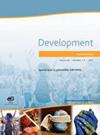文件背后的人——贾学圻和鹿山良一郎。
IF 3.6
2区 生物学
Q1 DEVELOPMENTAL BIOLOGY
引用次数: 0
摘要
体体形成的时空调控是由分割时钟的振荡信号控制的,如Hes7,但这些信号本身是如何协调的尚不清楚。在他们最新的研究中,Kageyama和他的同事们发现Cdh2是Hes7的一个以前未被报道的下游靶标,它通过同步Hes7的振荡和调节其他时钟成分ppERK的振荡,对体形成的时间具有重要的功能。为了了解更多关于这篇论文背后的研究人员以及这个故事是如何发展的,我们采访了第一作者Xueqi Jia和通讯作者RIKEN生物系统动力学研究中心主任Ryoichiro Kageyama。本文章由计算机程序翻译,如有差异,请以英文原文为准。
The people behind the papers - Xueqi Jia and Ryoichiro Kageyama.
Temporal-spatial regulation of somite formation is controlled by the oscillating signals of the segmentation clock, such as Hes7, but how these signals are themselves coordinated remain unclear. In their latest study, Kageyama and colleagues identify Cdh2 as a previously unreported downstream target of Hes7 that is functionally important for the timing of somite formation by both synchronising the oscillations of Hes7 and modulating the oscillations of fellow clock component ppERK. To find out more about the researchers behind the paper and how this story developed, we spoke to first author Xueqi Jia and corresponding author Ryoichiro Kageyama, Director of the RIKEN Center for Biosystems Dynamics Research.
求助全文
通过发布文献求助,成功后即可免费获取论文全文。
去求助
来源期刊

Development
生物-发育生物学
CiteScore
6.70
自引率
4.30%
发文量
433
审稿时长
3 months
期刊介绍:
Development’s scope covers all aspects of plant and animal development, including stem cell biology and regeneration. The single most important criterion for acceptance in Development is scientific excellence. Research papers (articles and reports) should therefore pose and test a significant hypothesis or address a significant question, and should provide novel perspectives that advance our understanding of development. We also encourage submission of papers that use computational methods or mathematical models to obtain significant new insights into developmental biology topics. Manuscripts that are descriptive in nature will be considered only when they lay important groundwork for a field and/or provide novel resources for understanding developmental processes of broad interest to the community.
Development includes a Techniques and Resources section for the publication of new methods, datasets, and other types of resources. Papers describing new techniques should include a proof-of-principle demonstration that the technique is valuable to the developmental biology community; they need not include in-depth follow-up analysis. The technique must be described in sufficient detail to be easily replicated by other investigators. Development will also consider protocol-type papers of exceptional interest to the community. We welcome submission of Resource papers, for example those reporting new databases, systems-level datasets, or genetic resources of major value to the developmental biology community. For all papers, the data or resource described must be made available to the community with minimal restrictions upon publication.
To aid navigability, Development has dedicated sections of the journal to stem cells & regeneration and to human development. The criteria for acceptance into these sections is identical to those outlined above. Authors and editors are encouraged to nominate appropriate manuscripts for inclusion in one of these sections.
 求助内容:
求助内容: 应助结果提醒方式:
应助结果提醒方式:


